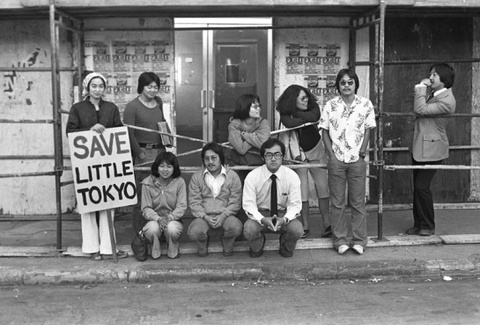The other day, I was walking from the Gold Line station, headed back to my job at the Little Tokyo Service Center. As I passed the old historic JANM (Japanese American National Museum) building, I had a big flashback.
Buddha’s Birthday (circa 1956)
My earliest memories of Little Tokyo include Hanamatsuri—the Buddha’s birthday.
Children from temples all over Southern California converged at the old Nishi Hongwanji—our Mother Temple, the previous inhabitant of the JANM historic building on First & Central.
I remember nothing of the service except the smell of incense. But afterwards, noisy kids rumbled down the stairs from the hondo, down to the ground floor, and burst out through the double doors and spilling onto the streets of Little Tokyo, clutching tightly to little pink tickets in hand.
The tickets were our reward for good behavior during the service and could be redeemed in any number of the shops for treats like manju, the best snow cones in town, gum, candy, or an ice cream cone at Kyodo drugstore with the old-fashion soda fountain counter; or comic books from the drug store at First & San Pedro, where you could sit and read them for hours at the very corner of the store that looked out onto that bustling intersection.
* * * * *
Fast-forward to 2013-14: By next summer, construction will begin on a new train station for the Regional Connector line, taking out Senor Fish, Weilands Brewery, and the Spice Table restaurant. This future station will be built one story down underground and will be located across the street from the newer JANM building. And it will change everything.
Predicted to be the second busiest station next to Union Station, this train will bring lots of people to Little Tokyo from all over the region. Could be good for business for those who survive the five-year construction. But the hyper-development that it promises to bring could speed up the changes we already see in the 130-year-old neighborhood.
As a Buddhist, I know that change is the norm and inevitable. Little Tokyo will never be that neighborhood I grew up visiting for Hanamatsuri, Nisei Week carnivals, or to buy Japanese goods. I can already see subtle but profound changes with new shops that now cater to a younger, hipper, multi-ethnic crowd. Designer sneaker shops, cafes that spill out onto the sidewalk, young people walking around dressed like anime characters, lots of dogs, and even baby carriages crowding the sidewalks.
This liveliness and excitement is pumping new life and energy into the area and giving rise to these new and different kinds of businesses. This is a big improvement from the empty storefronts and broken car windows of the 1990s. But where is the tipping point when Little Tokyo is no longer our neighborhood?

Evelyn, in center, with the Little Tokyo People’s Rights Organization, working to save Little Tokyo from redevelopment in the 1970s.
Many in the community who live, work, run businesses, attend temples & churches here, are asking ourselves that very question. We are coming together, looking past old differences and disagreements, trying to keep a handle on this suddenly-trendy area. The vibrancy is good, but we also need to keep a connection to that 130-year-old story. It’s not easy—to be inclusive and embracing of the future and the new, while remaining connected to so much history and culture. And in a genuine way.
But we’re trying. And we welcome participation from any of you out there who wants to help. The next 5-10 years could be make-or-break time for our neighborhood.
Join us. If you want to help us, email me at eyoshimura@ltsc.org.
*This article was originally published on From the VC Vault, October 25, 2013.
© 2013 Evelyn Yoshimura




